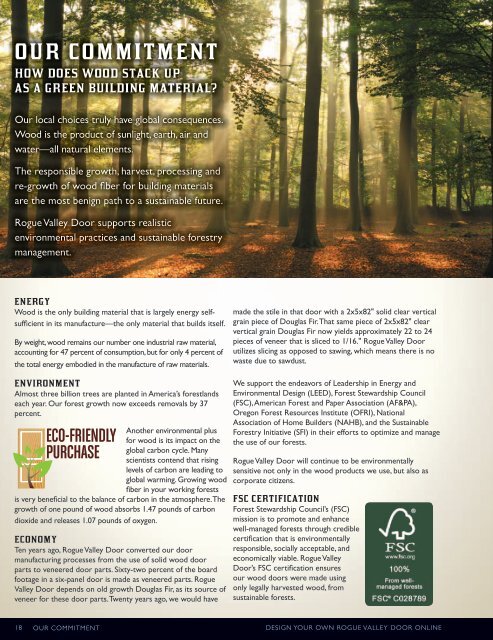1 DESIGN YOUR OWN ROGUE VALLEY DOOR ONLINE
1 DESIGN YOUR OWN ROGUE VALLEY DOOR ONLINE
1 DESIGN YOUR OWN ROGUE VALLEY DOOR ONLINE
You also want an ePaper? Increase the reach of your titles
YUMPU automatically turns print PDFs into web optimized ePapers that Google loves.
O U R C O M M I T M E N T<br />
HOW DOES WOOD STACK UP<br />
AS A GREEN BUILDING MATERIAL?<br />
Our local choices truly have global consequences.<br />
Wood is the product of sunlight, earth, air and<br />
water—all natural elements.<br />
The responsible growth, harvest, processing and<br />
re-growth of wood fiber for building materials<br />
are the most benign path to a sustainable future.<br />
Rogue Valley Door supports realistic<br />
environmental practices and sustainable forestry<br />
management.<br />
ENERGY<br />
Wood is the only building material that is largely energy selfsufficient<br />
in its manufacture—the only material that builds itself.<br />
By weight, wood remains our number one industrial raw material,<br />
accounting for 47 percent of consumption, but for only 4 percent of<br />
the total energy embodied in the manufacture of raw materials.<br />
ENVIRONMENT<br />
Almost three billion trees are planted in America’s forestlands<br />
each year. Our forest growth now exceeds removals by 37<br />
percent.<br />
Another environmental plus<br />
for wood is its impact on the<br />
global carbon cycle. Many<br />
scientists contend that rising<br />
levels of carbon are leading to<br />
global warming. Growing wood<br />
fiber in your working forests<br />
is very beneficial to the balance of carbon in the atmosphere. The<br />
growth of one pound of wood absorbs 1.47 pounds of carbon<br />
dioxide and releases 1.07 pounds of oxygen.<br />
ECONOMY<br />
Ten years ago, Rogue Valley Door converted our door<br />
manufacturing processes from the use of solid wood door<br />
parts to veneered door parts. Sixty-two percent of the board<br />
footage in a six-panel door is made as veneered parts. Rogue<br />
Valley Door depends on old growth Douglas Fir, as its source of<br />
veneer for these door parts. Twenty years ago, we would have<br />
made the stile in that door with a 2x5x82" solid clear vertical<br />
grain piece of Douglas Fir. That same piece of 2x5x82" clear<br />
vertical grain Douglas Fir now yields approximately 22 to 24<br />
pieces of veneer that is sliced to 1/16." Rogue Valley Door<br />
utilizes slicing as opposed to sawing, which means there is no<br />
waste due to sawdust.<br />
We support the endeavors of Leadership in Energy and<br />
Environmental Design (LEED), Forest Stewardship Council<br />
(FSC), American Forest and Paper Association (AF&PA),<br />
Oregon Forest Resources Institute (OFRI), National<br />
Association of Home Builders (NAHB), and the Sustainable<br />
Forestry Initiative (SFI) in their efforts to optimize and manage<br />
the use of our forests.<br />
Rogue Valley Door will continue to be environmentally<br />
sensitive not only in the wood products we use, but also as<br />
corporate citizens.<br />
FSC CERTIFICATION<br />
Forest Stewardship Council’s (FSC)<br />
mission is to promote and enhance<br />
well-managed forests through credible<br />
certification that is environmentally<br />
responsible, socially acceptable, and<br />
economically viable. Rogue Valley<br />
Door’s FSC certification ensures<br />
our wood doors were made using<br />
only legally harvested wood, from<br />
sustainable forests.<br />
18 OUR COMMITMENT <strong>DESIGN</strong> <strong>YOUR</strong> <strong>OWN</strong> <strong>ROGUE</strong> <strong>VALLEY</strong> <strong>DOOR</strong> <strong>ONLINE</strong>


